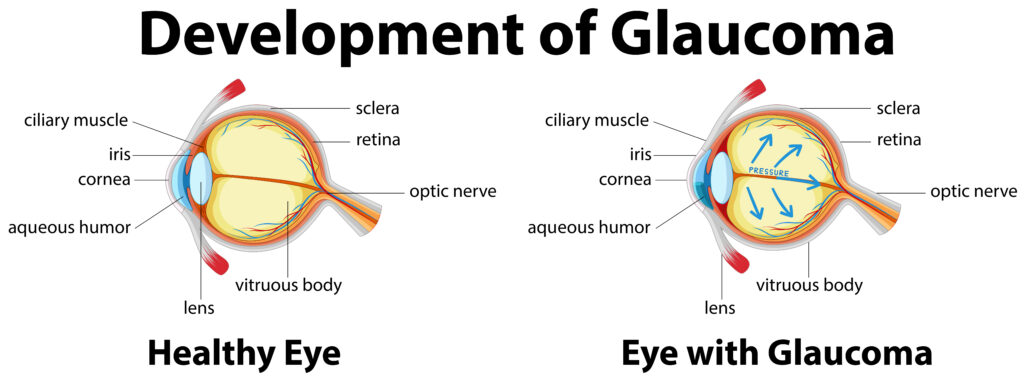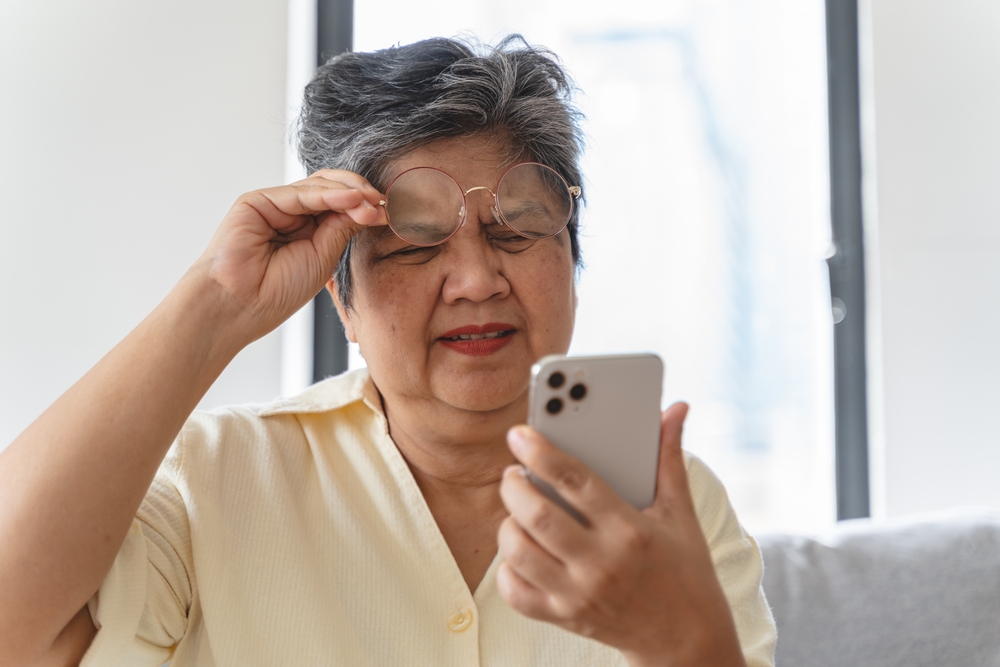
Glaucoma is a common eye condition that impacts around three million Americans. It’s also the second leading cause of blindness, making glaucoma a serious vision issue everyone needs to know about.
However, glaucoma is often challenging to detect, as glaucoma in its early stages usually does not have symptoms. Understanding the most common symptoms of this eye condition is essential for early detection.
Keep reading to learn more about what the most common symptoms of glaucoma are.
What Do I Need To Know About Glaucoma?

Glaucoma is a general term that refers to a group of eye conditions caused by optic nerve damage. Usually, glaucoma happens because of fluid build-up in the front of the eye.
This excess fluid increases pressure on the eye and, eventually, the optic nerve. This is known as intraocular pressure. However, it is possible to develop glaucoma even if you have normal eye pressure.
There are many kinds of glaucoma, with open-angle glaucoma being the most common. Many people will also develop glaucoma in both eyes.
What are the Common Symptoms Of Glaucoma?
Changes to your eyesight because of glaucoma can happen slowly, and some types of glaucoma don’t have many early symptoms at all. Still, it is important to know some of the more frequent signs across all types of glaucoma.
If you notice any of these symptoms or changes, don’t wait to make an appointment with your eye doctor at Hayden Vision. Treating glaucoma early can prevent vision loss, but it is irreversible once damage has occurred.
Eye Pain and Pressure
When glaucoma is caused by a build-up of pressure in the eye, you may notice increased pain or pressure in and around your eye. This is one of the most common signs of glaucoma, and it definitely shouldn’t be ignored.
Headaches
Headaches are a symptom of many health issues. If you have headaches, it may not be because of glaucoma.
More frequent or severe headaches are sometimes a cause for concern, however. It is best to consult your doctor if you are experiencing frequent or severe headaches.
If you have headaches along with other vision symptoms, it could be a sign of an eye condition.
Halos Around Lights
Halos around lights are a frequent symptom of vision problems. But, with glaucoma, you’re most likely to notice the halos are in rainbow colors.
Generally, if you see halos around lights, you should schedule an eye exam to figure out what’s going on.

Blurry Or Narrow Vision
Glaucoma can also impact your overall vision. It’s common to have blurry vision or tunnel vision. You may also notice blind spots or low vision.
These symptoms can also occur from cataracts or refractive errors, so an eye exam from your eye doctor is the best way to determine the cause.
Nausea Or Vomiting
Nausea and vomiting are also signs of many health issues. If you only have these symptoms, you likely have another health concern.
But, if you have nausea or vomiting in connection with vision changes, it could be glaucoma or another eye problem. In this case, the best thing to do is to book an appointment with your eye doctor.
Eye Redness
You may have red eyes when you’re tired or have allergies, but this is also a common symptom of glaucoma. If you’ve noticed eye redness that doesn’t have another underlying cause or aren’t sure, it’s a good idea to rule out glaucoma with a screening from your eye doctor.
What Causes Glaucoma?
In most cases, glaucoma is caused by a build-up of fluid and pressure on the optic nerve. Glaucoma can sometimes happen without specific causes, but many factors can increase your risk. These risk factors include:
- Your age, as your risk increases the older you get
- A family history of glaucoma or other eye conditions
- Your ethnicity, as people who are Black or Hispanic are more likely to develop glaucoma
- Having high or low blood pressure
- Using corticosteroids
- Having an eye injury or surgery
If you have these risk factors, especially if you have more than one, it’s even more important to receive regular eye exams to screen for glaucoma.
How is Glaucoma Treated?
If your eye doctor at Hayden Vision finds evidence of glaucoma, many treatments are available to help preserve your eye health and vision.
Medications

Glaucoma can be treated with prescription eye drops that decrease eye pressure in one of two ways. They can slow the amount of fluid produced within the eye or improve the flow of fluid drainage.
SLT (Selective Laser Trabeculoplasty)
SLT is a laser procedure that uses short pulses of low-energy laser light on cells within the trabecular meshwork that contain melanin. This helps fluids move through the drainage channels of your eye and decrease intraocular pressure.
iStent
The iStent Trabecular Micro-Bypass Stent is a device that makes a permanent opening in the fluid blockage of your eye. This results in improved flow of fluid and lowered eye pressure.
Trabeculectomy
A trabeculectomy is usually only considered to treat glaucoma if medications or laser eye surgeries do not prove effective at lowering eye pressure. The procedure involves making a small passage from the inside to the outside of your eye to reduce pressure and improve drainage.
Do you want to reduce your risk of permanent vision damage from glaucoma? Attending regular eye exams is the best way to detect signs of glaucoma and prevent the damage before it occurs. Schedule an appointment with Hayden Vision in Evansville, IN, today!
